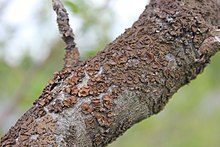| Melanohalea | |
|---|---|

| |
| Melanohalea exasperata | |
| Scientific classification | |
| Domain: | Eukaryota |
| Kingdom: | Fungi |
| Division: | Ascomycota |
| Class: | Lecanoromycetes |
| Order: | Lecanorales |
| Family: | Parmeliaceae |
| Genus: | Melanohalea O.Blanco, A.Crespo, Divakar, Essl., D.Hawksw. & Lumbsch (2004) |
| Type species | |
| Melanohalea exasperata (De Not.) O.Blanco, A.Crespo, Divakar, Essl., D.Hawksw. & Lumbsch (2004)
| |
| Species | |
|
see text | |
Melanohalea is a genus of foliose lichens in the family Parmeliaceae. It contains 30 mostly Northern Hemisphere species that grow on bark or on wood. The genus is characterised by the presence of pseudocyphellae (tiny pores that allow for gas exchange), usually on warts or on the tips of isidia, a non-pored epicortex and a medulla containing depsidones or lacking secondary metabolites. Melanohalea was circumscribed in 2004 as a segregate of the morphologically similar genus Melanelia, which was created in 1978 for certain brown Parmelia species. The methods used to estimate the evolutionary history of Melanohalea suggest that its diversification primarily occurred during the Miocene and Pliocene epochs.
Melanohalea species predominantly inhabit bark and wood in the Holarctic, with only a few extending into the Southern Hemisphere and rare occurrences on rocks. Notably, Melanohalea peruviana in the Peruvian Andes and M. mexicana in Mexico represent the genus's limited tropical distribution. The distribution of these lichens, which are sensitive indicators of climate and pollution effects, is largely determined by current ecological and geographical factors. Certain species show vulnerability to climate change and environmental pollutants. Many species of lichenicolous (lichen-dwelling) fungi are known to parasitise the lichen. Several Melanohalea species are listed as endangered or critically endangered on national red lists across Europe, reflecting their varying levels of threat due to habitat loss, pollution, and climate change. Only M. halei has been assessed globally by the IUCN and is listed as being of least concern due to its widespread distribution and stable population.